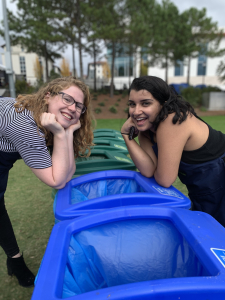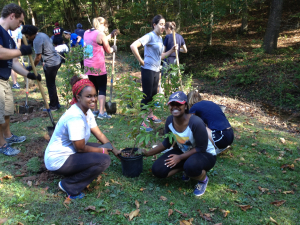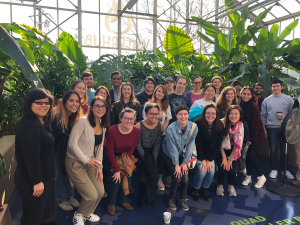Dispelling the Myth of the Emory Bubble: Connecting Calls to Action from the Environmental Justice Movement to Campus and Community Change
Many who come to Emory, especially undergraduate students, may have heard the term “the Emory Bubble,” which is most often used to describe a feeling of geographic and social disconnect between Emory community members and the greater Atlanta area. Whether or not Emory students feel the Emory Bubble, Emory is in reality very connected to, reliant upon, and has an impact on the people and environments of our surrounding neighborhoods, of our supply chains, of our utility providers, and of our research contexts. What Emory does operationally, academically, programmatically, institutionally and to conduct and to utilize our research affects systems of environmental injustice and can play various roles in shifting systems toward justice.

The 2012 Greenlaw report on the intersections between pollution and demographics, referenced in the blog #3 of this series, showed that “race is the characteristic with the strongest correlation to pollution” (Deganian & Thompson, 2012). This publication further justified the expanding focus of Emory University to reduce and divert waste from its campuses that started in the late 1980s with concerned librarians wanting to recycle white paper and has grown to a campus-wide Waste Management Policy in 2018 that created a diversion system that kept an average of 75% of the total campus waste out of landfills in the first 3 months of 2020 (77% in January, 77% in February and 71% in March). The landfill waste from Emory’s campuses currently goes to Pine Ridge Landfill established in 1987 in Griffin, Georgia. This particular landfill is a landfill-gas-to-energy plant that captures methane gas, a particularly potent greenhouse gas, and converts it to a clean-burning fuel. The clean-burning fuel produced from this landfill can power 4,272 homes (Mas Energy, n.d.). However, the majority of citizens living in Griffin are people of color, low-income, and have less than a high school education. Decades of work designing a comprehensive waste management program and waste reduction initiatives, such as the Zero Waste Ambassadors, the Green Office at Emory, the Green Labs at Emory and the Sustainable Events Certification program, have all been grounded in an effort to help community members understand our connection to communities, like Griffin, and to take conscious actions to reduce their contributions to polluting industries that affect those who live near these facilities.

Awareness of persistent water quality, stormwater management, and freshwater scarcity issues and the disproportionate impact of these challenges felt by neighborhoods downstream from the Emory campus has guided a decade and a half of increasingly comprehensive water stewardship practices, policy and infrastructure. To use less water, low-flow fixtures have been employed in many campus buildings. To manage stormwater, green infrastructure, such as rain gardens, bioswales, and green roofs, has been designed into campus spaces. The Office of Sustainability Initiatives and Campuses Services also engage students who help plant pollinator-attractive flowers, shrubs, and trees in buffers along Emory’s streambanks (STARS, 2017). In 2014, Emory banned harmful pesticides that are contributing to the global decline of pollinator populations and committed to expanding safe pollinator habitats. The buffers alongside the streambanks slow and clean stormwater runoff from campus, in turn increasing the water quality that leaves our campus and flows downstream to West Atlanta neighborhoods. In 2015, Emory University became home to the WaterHub at Emory, a water recycling system that uses eco-engineering processes to clean waste water for non-potable uses, like heating and cooling buildings and flushing toilets. The WaterHub is essential for water conservation, as Atlanta is one of the largest municipalities located in the smallest watersheds in the country. This system reduces the draw of water from Atlanta’s municipal water supply by up to 146 million gallons of water annually, while also reducing the risk of sewer overflows from aging pipe infrastructure during heavy rain events.
Globally, we know that the existing socioeconomic inequalities have been further heightened by impacts of climate change. Those experiencing more extreme weather events, poorer air quality, extreme heat, and correlated environmental strains on resources are those who often contribute the least to greenhouse gas emissions causing climate change. Emory started measuring its greenhouse gas emissions in 2005, when collectively the University was emitting over 370,000 megatons of carbon dioxide equivalents. 15 years later, Emory has built the Cliff Shuttle System, which transports around 3 million riders annually to and from Emory facilities for free and runs on a B5 biofuel blend made from campus and hospital used cooking oils. Emory has extended the multi-use trail network connecting to and across many parts of the Druid Hills campus, and Emory has built a sustainable commute options program to encourage reduction of individual emissions from commuter travel. Emory has adopted a LEED green building standard for new buildings and renovations, has employed best practices when retrofitting existing buildings for energy efficiency and has created programs intended to motivate energy use reduction by individuals. This year, Emory announced an alignment with the Intergovernmental Panel on Climate Change’s 2018 targets for emissions reduction–cut carbon emission 45% by 2030 and reach net zero emissions by 2050. As of May, Emory University is partnering with Cherry Street Energy to install over 15,000 solar panels on 16 Emory buildings and parking structures to generate renewable solar energy. Through Cherry Street’s Shine On workforce development program, workers formerly displaced by other industries have been trained and employed in the growing solar industry, and they will install panels that are expected to generate about 10% of Emory’s peak energy use. By reducing fossil fuel usage and by generating more renewable clean energy, Emory is working to contribute to a more just energy system in the region, a system that is currently centered on coal, natural gas, and a growing amount of nuclear energy. Marginalized and vulnerable communities often live near these facilities and are disproportionately affected by the negative health, economic, and environmental impacts of these forms of energy generation (NAACP, n.d.).
Emory’s regional context has also affected what we eat, the ways that our food is grown, and who most likely grows it. The agricultural economy of the southeastern United States benefits from a good climate and topography for year-round cultivation in many areas, but its history is marred by systems of slavery, indentured servitude, and forced displacement of indigenous peoples. The legacy of these systems of oppression are still seen in the amount of farmland owned by Black, Indigenous, and other peoples of color today. Of the country’s 3.4 million total farmers, only 1.3% or 45,508 are black, compared to about 95%, or 3.2 million+, of farmers who are white. Black farmers own about 0.45% of America’s farmland, compared to about 93% of farmland owned by white farmers (USDA, 2017). These staggering statistics highlight why it is important to intentionally uplift diverse farmers in the region. Emory has intentionally worked to rebuild a healthy southeastern agricultural system, but one based on values of social justice, sustainable practices, and resiliency. In 2019, Emory entered into a partnership with the Working Farms Fund, which aims to break down the barriers that many young and minority farmers face, including financial constraints and land ownership issues, when trying to start a farming enterprise. The Conservation Fund’s Working Farms Fund will purchase farmland within 100 miles of metro-Atlanta, protect the lands from development and environmental degradation, and lease the land to farmers with a 5- or 10-year path to ownership (Emory University, 2019). Emory has committed to purchasing food from these farmers, a commitment which they can use to secure traditional financing as well as to secure a market for their products.

Emory also has impressive faculty and staff working on applied research in various disciplines to mitigate the impacts of environmental racism and to build healthier communities. Dr. Eri Saikawa is working on a soil lead project that led the EPA to investigate soil contamination in Atlanta’s westside community. Dr. Charles Moore has a particular focus on head and neck cancer incidence in medically underserved communities (Urban Health Initiative, 2019). Dr. Veda Johnson is the director of PARTNERS for Equity in Child and Adolescent Health, which aims to increase access to quality healthcare and improve delivery of pediatric primary care through a coordinated and comprehensive health model (Emory School of Medicine, 2018). These researchers and practitioners are only a few of the many at Emory whose work for justice has culminated into multiple collaborative networks. The Southeast Pediatric Environmental Health Specialty Units (SE PEHSU) has a “Break the Cycle” program which tracks environmental impacts on children’s health, especially among populations which have environmental hazards related to circumstances of social and economic disadvantage (Emory School of Medicine, 2019). The Resilience and Sustainability Collaboratory (RSC) is a “think-and-do-tank” that leverages the collective expertise of corporate leaders, Emory faculty and staff, government, and community organizations to plug into actionable projects that generate innovative solutions to sustainability and resilience challenges impacting our global society. Emory also co-wrote the application for the Greater Atlanta Metropolitan Area with Spelman and Georgia Tech to receive the designation from the United Nations as a Regional Centre of Expertise on Education for Sustainable Development (UN RCE), which fosters a collaborative network to enhance regional sustainability and to implement the UN’s Sustainable Development Goals.
Building campus operational systems and applied academic collaborative networks informed by the calls for action from the environmental justice movement has reduced Emory’s negative impacts on resource use and climate change, while also shifting resources to more just systems. The work is far from over, and the centering of justice for all in our systems is a generations-long process. We all have part to play. Are you wondering what you can do as a part of the Emory Community to further the environmental justice movement? Be sure to reduce your waste by reusing and diverting it when you must dispose of something. Consider becoming a Zero Waste Ambassador. Protect our water treatment infrastructure by keeping wipes out of pipes. Support local BIPOC and women farmers. Try out other ways to commute that don’t contribute to emissions – like taking the Cliff Shuttle System, walking or riding your bike; this includes reducing your air travel. If you are able, consider joining community solar efforts like Solarize DeKalb. Generally, ask questions about the systems and policies affecting your everyday life and how they do or do not move toward justice. Ask how your discipline, industry or area of research may or may not contribute to systems built on environmental racism and challenge yourself to envision ways to advocate for transforming these systems.
Sources Cited:
Deganian, D. & Thompson, J. (March 2012). The Patterns of Pollution: A Report on Demographics and Pollution in Metro Atlanta [PDF]. Retrieved from https://greenlaw.org/pdf/PatternsofPollutionFINALGreenLaw3-26-2012.pdf
Emory School of Medicine. (2018). About Us. Retrieved from https://med.emory.edu/departments/pediatrics/divisions/general/partners/about/index.html
Emory School of Medicine (2019). SE Pediatric Environmental Health Specialty Unit. Retrieved http://www.pediatrics.emory.edu/centers/pehsu/index.html
Emory University. (2019, November 13). From Georgia Farms to Emory Tables. Retrieved from https://news.emory.edu/features/2019/11/farms-to-tables/index.html
Mas Energy. (n.d.). Fact Sheet: Richland Creek, Oak Grove and Pine Ridge [PDF] Retrieved from http://mas-energy.com/media/7799/masenergy-factsheet-ga_lfg.pdf
NAACP. (n.d.). Georgia Energy Justice Snapshot [PDF]. Retrieved from http://www.naacp.org/wp-content/uploads/2015/09/Georgia-Snapshot.pdf
STARS. (2017, July 25). Emory University IN-26: Innovation C. The Sustainability Tracking, Assessment & Rating System. Retrieved from https://reports.aashe.org/institutions/emory-university-ga/report/2017-07-25/IN/innovation/IN-26/
Urban Health Initiative. (2019). Leadership. Retrieved from http://urbanhealthinitiative.emory.edu/Meet%20us/leadership/index.html
USDA. (2017). Selected Farm Characteristics by Race: 2017 [PDF]. Retrieved from https://www.nass.usda.gov/Publications/AgCensus/2017/Full_Report/Volume_1,_Chapter_1_State_Level/Georgia/st13_1_0061_0061.pdf
